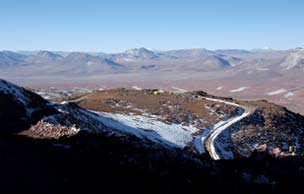
The Radiative Heating in Underexplored Bands Campaign (RHUBC II) was selected for support by ARM as an off-site campaign in 2009. Led by principal investigators Dr. David Turner and Dr. Eli Mlawer, RHUBC-II will take place from August to October 2009 at a location near Cerro Chajnantor in Chile, at an altitude of more than 5,000 m. This effort is a follow-on to RHUBC, conducted from February 22 to March 14, 2007, at the ARM North Slope of Alaska site in Barrow. RHUBC-I was the first experiment to make detailed observations of downwelling infrared radiation in the far-infrared (wavelengths greater than 15 μm). This spectral region has been underexplored to date and is normally opaque at the surface due to strong absorption by water vapor.
During RHUBC-II, the same spectral band will be explored; however, this absorption band is much more transparent in the dry, low pressure conditions at Chajnantor. Thus, useful measurements can be made to even longer wavelengths than was possible during RHUBC-I. RHUBC-II will also investigate the normally opaque water vapor bands in the near-infrared (wavelengths between 1 and 3 μm), which could not be investigated during RHUBC-I due to the low sun angles during the polar winter. In both spectral regions, the observed radiance will be compared against high-resolution calculations from advanced radiative transfer models, which should greatly reduce the uncertainties associated with modeling these spectral bands. RHUBC-II will provide scientific data to document the extent of upper tropospheric cooling as an effective regulator of global warming. The current uncertainty associated with water vapor absorption in these bands can lead to assumptions about their cooling effect in the upper troposphere, which is reflected in model simulations of global climate.

